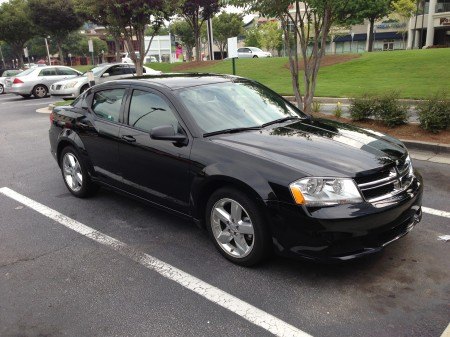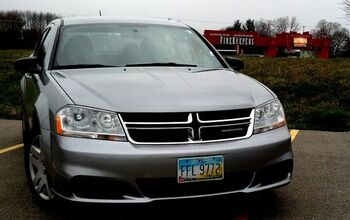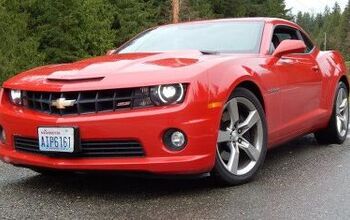Rental Car Review: 2013 Dodge Avenger

I had dinner recently with TTAC’s enfant terrible, Doug Demuro, something we do every few weeks as our respective schedules permit. Predictably, our pre-, mid- and post-prandial conversation revolved around our shared passion for automobiles, as well as the people who read and write about them. At one point I made a hasty proclamation, which was in retrospect unwise given my audience: “Doug, I really don’t think any manufacturers are making objectively bad cars right now.” Doug paused and replied: “My friend, have you ever heard of Chrys-ler?,” enunciating the last pair of syllables as if speaking to an alien. He continued, “check out the 200 if you have a chance.”
As (bad) luck would have it, I found myself at the local Porsche dealer not long ago, eager to trade my hard-earned dollars in exchange for renewed braking capabilities for my car. As always, they were bereft of loaner cars, but they promised to provide me with an Enterprise rental car. After leaving my 911 at its home-away-from-home – I am legitimately on a first name basis with the majority of the service department at my local Porsche emporium – I rode with the Enterprise lady (they really did pick me up!) to their nearby lot. I was confronted with two options – a ubiquitous Ford F-150 or a 2013 Dodge Avenger. Mindful that the Avenger is the ostensibly edgier stablemate of the aforementioned Chrysler 200, as well as some recent accolades directed at the sub-prime striver’s car of choice I chose the Dodge. After the perfunctory walk-around and paperwork, I was on my way.
Truth be told, I was a little excited to try out the Dodge. Walter P. Chrysler’s namesake company has endured ups and downs and a variety of masters and bedfellows throughout its nearly 90-year history. Like anyone who would name a car after himself, or commission an iconic, Art Deco Manhattan skyscraper with the same nomenclature, the eponym obviously took great pride in his body of work, the representation of his endeavors. The company endured after his passing, but fell on hard times by the late 1970s, with newly hired executive Lee Iacocca approaching Congress for a bailout in late 1979. After over $1 billion in backstopping, Chrysler was back on its feet in the next decade, riding the successful restructuring and the strength of its product offerings, including the minivan. Chrysler later consorted with Daimler and ended up in the arms of private equity sponsor Cerberus after the dissolution of the uneasy union with the Germans. The automaker suffered more misfortune courtesy of the financial crisis and filed for Chapter 11 bankruptcy reorganization in the spring of 2009. A curious ownership structure resulted, with Fiat and the United Auto Workers union sharing custody of the company. In recent years we’ve seen Super Bowl sloganeering that appeals to emotion – “ Imported from Detroit”, “ Halftime in America”, and “ God Made a Farmer” in succession – and suffered partisan bloviating and mudslinging concerning the company’s direction.
But how are the products, the cars that the company designs and manufactures with the intention of returning a profit to its owners? I wanted to find out.
My Avenger for a few days was a 15,000 mile example that was already showing considerable wear due to its rental fleet usage. Upon getting settled inside I was struck by the exceptionally cheap plastics that permeated the interior. Enterprise had helpfully added an admonishment against smoking inside the car, presumably to prevent those trapped inside it from attempting self-immolation.
I adjusted the trio of mirrors in an attempt to enhance rearward visibility, but it was futile. You might forgive compromised situational awareness in, say, a Lamborghini Countach, but I found this distressing in the Dodge, in particular the enormous blind spots created by the plastic cladding extending from the c-pillars.
This design feature was apparently elected to facilitate the placement of aerodynamic addenda on the exterior, ensuring that the rear end of this front-wheel drive economy car remains planted during aggressive maneuvering.
While I wasn’t able to position the rear-view mirror at any angle that afforded a reasonable view of whatever was tailgating me, I was permitted an excellent view of the rear shelf, which appeared to be upholstered in scraps that otherwise could have been used to form the coarse outer covering for a stack of Marshall amplifiers.
I eventually composed myself and reasoned that the poor visibility could be a blessing in disguise – I couldn’t see out, but no one else would be able to see me driving the car. I cranked the engine and returned to work. The Avenger featured 4 cylinders and 4 forward gears, and it moaned like a dying animal when anything beyond half throttle was applied. The transmission proved extraordinarily dimwitted, pausing for several seconds before swapping cogs, even when cruising on surface streets. The steering wheel featured small buttons on its reverse, and I hoped that they would allow me to control gear selection, just like Doug’s Cadillac CTS-V station wagon, which was also made by a bailed-out domestic automaker. Instead, I later found out via the world-wide web that the buttons controlled the car’s stereo, although on my car they were already broken (or never functional), as pressing them elicited no response from the Dodge.
Speaking of the steering wheel… steering feel is often discussed by car reviewers and enthusiasts, but its something that’s quite difficult to describe adequately using only words. It depends on the complex interplay among weighting, linearity of response, and the transmission of the tires’ relationship with the tarmac back to the helm; perhaps it’s a bit like pornography, you know it when you feel it. You also know when you don’t feel it, and the Avenger provided no feel whatsoever. It reminded me of playing Cruis’n USA at the local arcade as a child.
Despite the record levels of rain that have plagued Atlanta this year, it still gets hot in the Dirty South during the Dog Days of summer. I cranked up the air conditioning on my maiden voyage, but quickly noticed that it mostly provided a huffing and puffing of sound and fury, rather than serving its intended purpose, so I just rolled down the windows instead. The Avenger’s window switches are quite interesting. Whereas my 20th century Porsche’s switches return a precise click upon reaching their detents, the Dodge’s switches appear to be made from a Styrofoam packing peanut that was spray-painted black. They are so flimsy that I could easily detach them from their housings using only two fingers.
The passenger side window features an ironic sticker.
There’s no pride to be taken in any aspect of the Dodge Avenger. There’s no pride to be taken by the taxpayers who have facilitated the continued existence of this stinker of a car. There’s none of that pride that Walter P. Chrysler had when he put his name on his cars. All that’s left is shame.
David Walton grew up in the North Georgia mountains before moving to Virginia to study Economics, Classics, and Natural Light at Washington and Lee University. Post-graduation, he returned to his home state to work in the financial services industry in Atlanta. A lifelong automotive enthusiast, particular interests include (old) Porsches and sports car racing.

David Walton grew up in the North Georgia mountains before moving to Virginia to study Economics, Classics, and Natural Light at Washington and Lee University. Post-graduation, he returned to his home state to work in the financial services industry in Atlanta. A lifelong automotive enthusiast, particular interests include (old) Porsches and sports car racing.
More by David Walton
Latest Car Reviews
Read moreLatest Product Reviews
Read moreRecent Comments
- W Conrad I'm not afraid of them, but they aren't needed for everyone or everywhere. Long haul and highway driving sure, but in the city, nope.
- Jalop1991 In a manner similar to PHEV being the correct answer, I declare RPVs to be the correct answer here.We're doing it with certain aircraft; why not with cars on the ground, using hardware and tools like Telsa's "FSD" or GM's "SuperCruise" as the base?Take the local Uber driver out of the car, and put him in a professional centralized environment from where he drives me around. The system and the individual car can have awareness as well as gates, but he's responsible for the driving.Put the tech into my car, and let me buy it as needed. I need someone else to drive me home; hit the button and voila, I've hired a driver for the moment. I don't want to drive 11 hours to my vacation spot; hire the remote pilot for that. When I get there, I have my car and he's still at his normal location, piloting cars for other people.The system would allow for driver rest period, like what's required for truckers, so I might end up with multiple people driving me to the coast. I don't care. And they don't have to be physically with me, therefore they can be way cheaper.Charge taxi-type per-mile rates. For long drives, offer per-trip rates. Offer subscriptions, including miles/hours. Whatever.(And for grins, dress the remote pilots all as Johnnie.)Start this out with big rigs. Take the trucker away from the long haul driving, and let him be there for emergencies and the short haul parts of the trip.And in a manner similar to PHEVs being discredited, I fully expect to be razzed for this brilliant idea (not unlike how Alan Kay wasn't recognized until many many years later for his Dynabook vision).
- B-BodyBuick84 Not afraid of AV's as I highly doubt they will ever be %100 viable for our roads. Stop-and-go downtown city or rush hour highway traffic? I can see that, but otherwise there's simply too many variables. Bad weather conditions, faded road lines or markings, reflective surfaces with glare, etc. There's also the issue of cultural norms. About a decade ago there was actually an online test called 'The Morality Machine' one could do online where you were in control of an AV and choose what action to take when a crash was inevitable. I think something like 2.5 million people across the world participated? For example, do you hit and most likely kill the elderly couple strolling across the crosswalk or crash the vehicle into a cement barrier and almost certainly cause the death of the vehicle occupants? What if it's a parent and child? In N. America 98% of people choose to hit the elderly couple and save themselves while in Asia, the exact opposite happened where 98% choose to hit the parent and child. Why? Cultural differences. Asia puts a lot of emphasis on respecting their elderly while N. America has a culture of 'save/ protect the children'. Are these AV's going to respect that culture? Is a VW Jetta or Buick Envision AV going to have different programming depending on whether it's sold in Canada or Taiwan? how's that going to effect legislation and legal battles when a crash inevitibly does happen? These are the true barriers to mass AV adoption, and in the 10 years since that test came out, there has been zero answers or progress on this matter. So no, I'm not afraid of AV's simply because with the exception of a few specific situations, most avenues are going to prove to be a dead-end for automakers.
- Mike Bradley Autonomous cars were developed in Silicon Valley. For new products there, the standard business plan is to put a barely-functioning product on the market right away and wait for the early-adopter customers to find the flaws. That's exactly what's happened. Detroit's plan is pretty much the opposite, but Detroit isn't developing this product. That's why dealers, for instance, haven't been trained in the cars.
- Dartman https://apnews.com/article/artificial-intelligence-fighter-jets-air-force-6a1100c96a73ca9b7f41cbd6a2753fdaAutonomous/Ai is here now. The question is implementation and acceptance.








































Comments
Join the conversation
You wanna rent a fun car that is sort of a Chrysler, rent a FIAT 500 You left the second i out of vitriol, imatt.
Late to the party here but having had one for a week in Florida, I agree with most of this article. The engine/tranny combo IS abominable! I was wondering, was the black plastic piece that runs up from the console onto the top of the dash warped? The Florida sun had done this one in. However, I will say two positive things...the engine/tranny combo did produce decent mileage and the a/c in mine worked very well.